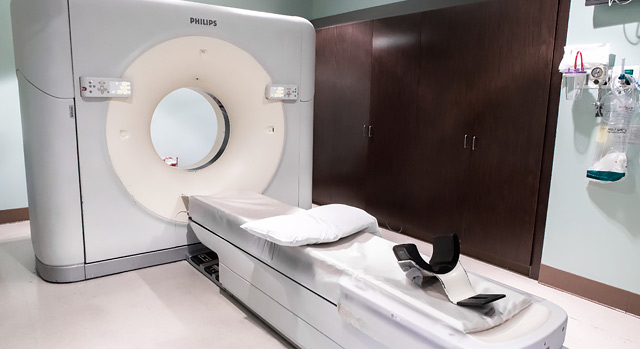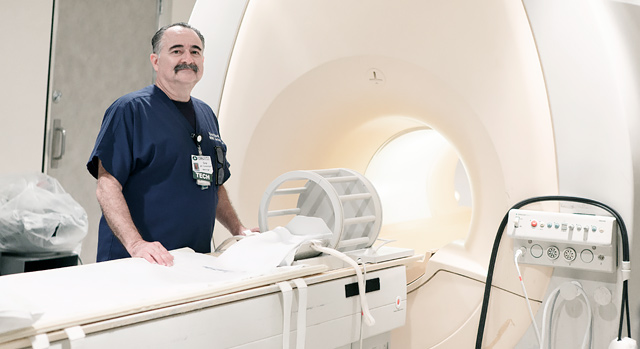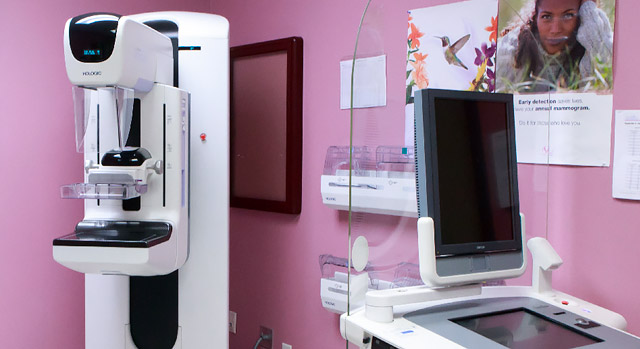Convenient Medical Imaging Services
Radiologists at Doctors Hospital of Laredo are trained to perform tests that provide images of different areas of the body to help physicians diagnose and treat conditions. To best meet your needs, imaging and testing is available at multiple locations:
North Laredo
Doctors Hospital (main campus)
10700 McPherson Road
For scheduling, call 956-523-2740
Providence Health Center
230 Calle Del Norte
For scheduling, call 956-523-2740
South Laredo
South Laredo Diagnostic Center
3527 Jaime Zapata Memorial Highway, Suite 104
Walk-ins welcome
956-523-6440
Imaging and Diagnostic Tests Offered
Doctors Hospital offers the following tests and diagnostic services:
X-ray
An X-ray image is produced when a small amount of radiation passes through the body to expose sensitive film on the other side. The ability of X-rays to penetrate tissues and bones depends on the tissue's composition and mass. The difference between these two elements creates the images. The chest X-ray is the most common radiologic examination. Contrast agents, such as barium, can be swallowed to highlight the esophagus, stomach and intestine and are used to help visualize an organ on film.
Computed Tomography (CT) Scans
Computed tomography or CT is a type of low radiation X-ray that can take very detailed pictures of organs, bones and tissue. During a CT scan, a patient lies in the machine while a ring moves around them taking images taken from different angles to produce cross-sectional images or slices of the anatomy. Together, the slices can be formatted to create a complete internal image of the body. CT scans are helpful in examining the chest, abdomen and pelvis, as well as detecting cancerous tumors and vascular diseases.
Magnetic Resonance Imaging (MRI)
MRI uses a large magnet that surrounds the patient, radio frequencies and a computer to produce images of the body. As the patient enters a MRI scanner, his body is surrounded by a magnetic field up to 8,000 times stronger than that of the earth. The scanner subjects nuclei of the body's atoms to a radio signal, temporarily knocking select ones out of alignment. When the signal stops, the nuclei return to the aligned position, releasing their own faint radio frequencies from which the scanner and computer produce detailed images of the human anatomy. Patients who cannot undergo a MRI examination include those people dependent upon cardiac pacemakers and those with metallic foreign bodies in the brain or around the eye.
MRI uses radio waves and a strong magnetic field to create clear pictures of internal organs and tissues. No radiation exposure is involved since MRI does not use X-rays. MRI is useful in diagnosing diseases in all parts of the body including cancer, vascular and heart disease, liver and bile duct abnormalities, stroke and other neurological diseases, as well as joint and musculoskeletal disorders. Most MRIs require a small intravenous injection of a contrast agent that contains the metal Gadolinium.
Nuclear Medicine
Nuclear medicine, which uses radioactive material to diagnose and determine the severity of disease, offers unique diagnostic information about the function of many organs in the body that other imaging methods may not provide. This form of imaging can often identify abnormalities very early in the progression of a disease; this enables treatment to begin at the earliest stage of a disease. Nuclear medicine is used to diagnose and monitor a wide range of diseases, including various cancers, heart disease, endocrine, gastrointestinal and neurological disorders.
Ultrasound (Sonography)
Ultrasound uses high frequency sound waves to see inside the body. A transducer — a device that acts like a microphone and speaker — is placed in contact with the body using a special gel that helps transmit the sound. As the sound waves pass through the body, echoes are produced and bounce back to the transducer. By reading the echoes, the ultrasound can produce images that illustrate the location of a structure or abnormality, as well as provide information about its composition. Most often used to view a baby in utero, ultrasound is also used to examine the heart, liver, pancreas, spleen, blood vessels, breast, kidney or gallbladder.
Digital Mammography
The most widely used and recognized imaging method for the detection of breast cancer is a mammogram. Traditional mammography uses X-rays to produce films of the breast. Digital mammography, which produces electronic pictures of the breast, uses a lower does of radiation to detect abnormalities before anything can be felt.
Download information about breast cancer and guidelines for screenings (PDF) >
Learn More About Digital Mammography
Bone Density Scan
A bone density scan uses low-dose X-ray images to determine if you have osteoporosis, a disease that causes bones to become more fragile and more likely to break. The results of a bone density scan can also predict which bones have more risk of breaking before the fact. People may not know that they have osteoporosis until a sudden strain, bump, or fall causes a bone to break. Bone density tests typically focus on bones that are most likely to break
because of osteoporosis such as the lower spine (lumbar vertebrae), the narrow neck of the thighbone (femur) and bones in the forearm. Osteoporosis is common in older women. As many as half of all women and a quarter of men older than 50 will break a bone due to osteoporosis. Risk factors include:
- Age
- Being small and thin
- Family history of osteoporosis
- Taking certain medicines
- Being a white or Asian woman
- Having osteopenia, which is low bone density
Interventional Radiology
Services from Doctors Hospital of Laredo may include:
-
Peripheral angiography, angioplasty, stent, atherectomy, thrombolysis
- Non-healing foot wounds, gangrene, renal arteries, carotid/cerebral angiograms
- Mesenteric ischemia
- Subclavian steal syndrome
-
Angiograms and embolization for bleeding
- Gastrointestinal bleeds, bronchial artery for hemoptysis, tumors, etc.
- Trauma: spleen, liver, kidney, pelvis
- Uterine fibroids embolization for bleeding/pelvic pain
- Peripheral pseudoaneuryms and aneurysms
-
Central venous access
- Chest ports for chemo, tunneled catheters for IV antibiotics and TPN
- Placement, removals, revision of nonfunctioning catheters
-
Interventional oncology
- Chemoembolization for hepatocellular carcinoma and metastatic liver tumors
-
Ascites/pleural effusion management
- Ultrasound guided paracentesis/thoracentesis
- Chest tube placement for pleural effusion, empyema, pneumothorax
- Tunneled pleural/peritoneal catheters for refractory ascites/effusions
-
Dialysis access
- Fistulagrams, angioplasty, thrombectomy for nonfunctioning grafts/fistulas
- Angiograms for dialysis access steal syndrome and ischemia
-
Biliary/Portal hypertension
- Cholecystostomy tube placement, biliary drainage catheter placement/stent
- TIPS insertion/revision for refractory ascites and variceal bleeds
-
Renal
- Percutaneous nephrostomy insertion, nephroureteral stent
-
Biopsy/Drainage
- Liver, kidney, lymph nodes, neck masses, thyroid, lung, soft tissue masses, ultrasound guided breast biopsy
- Drainage of abscesses and postoperative fluid collections
-
Venous disease/Deep vein thrombosis
- Inferior vena cava filter placement and removal
- DVT thrombolysis/thrombectomy
- Superior cava syndrome/Paget Schroetter



